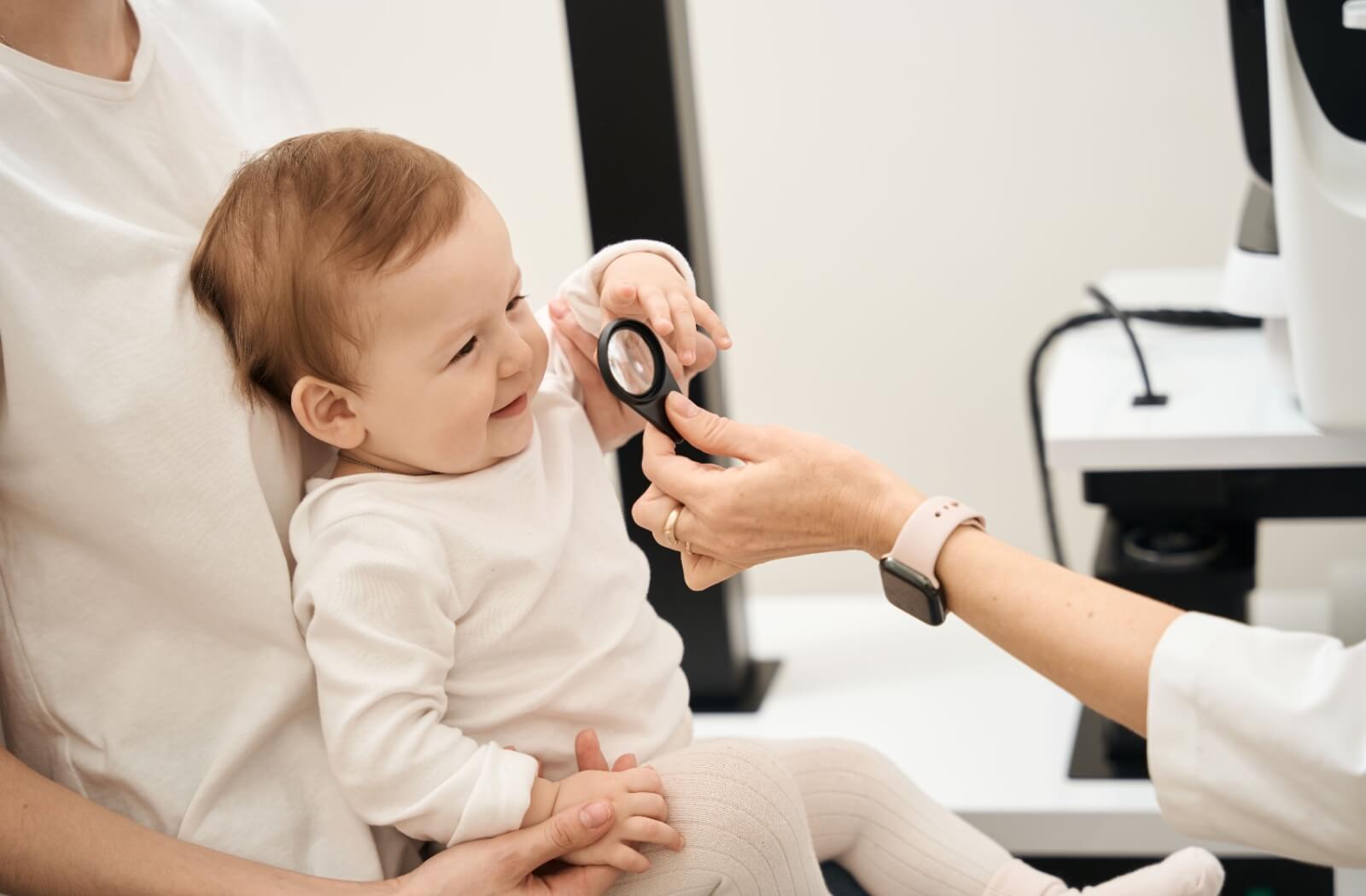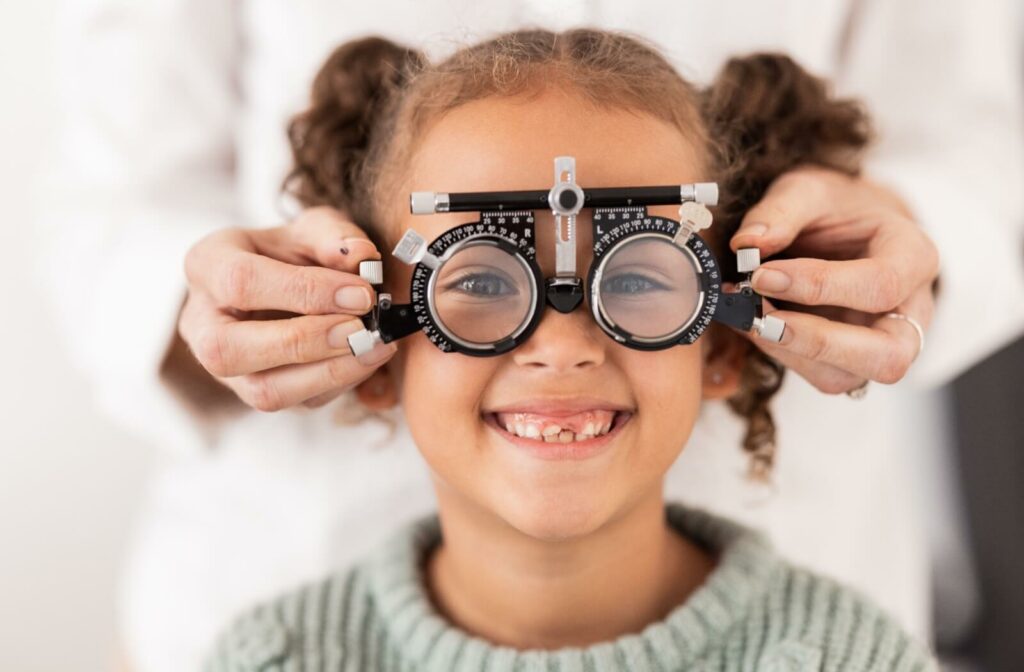Being present in your child’s learning and development includes taking a proactive step in safeguarding their vision and ocular health.
Children are encouraged to have an eye exam once a year until 19 years of age. Children are also recommended to have an eye exam at the following times:
- First eye exam between 6 to 9 months.
- At least one eye exam between 2 to 5 years old.
- Annual eye exams from 6 to 19 years old.
The provincial government recognizes the importance of children’s eye exams for favourable learning and development. This is why children 18 and under are covered for their comprehensive eye exams once a year through the Alberta Health Care Insurance Plan.
Importance of Children’s Eye Exams
The significance of comprehensive eye exams goes beyond evaluating visual clarity. Routine eye exams offer an in-depth assessment of vision and ocular health.
In addition to prescribing updated glasses, these exams can help uncover underlying eye conditions and may improve children’s performance in school.
Early Detection of Eye Conditions
Some eye conditions develop without manifesting immediate symptoms, making routine visits to your optometrist vital. Early detection is key to managing and treating certain eye conditions, allowing for improved visual outcomes.
Often, children may not even realize they’re experiencing visual problems because their perception of the world appears “normal”. Routine visual screenings help correct any refractive errors that may impact their visual clarity.
Your optometrist will screen for eye conditions that are commonly found in children, which include:
- Amblyopia
- Binocular vision dysfunction
- Convergence insufficiency
- High myopia
- Pediatric cataracts
- Strabismus
Visual Learning & Development
During a child’s first 12 years, 80% of their learning is visual, making healthy vision a significant element in their learning and development.
Children use their vision to explore the world around them, interact with people, and engage in activities. Poor vision can impact their ability to lead, write, focus, and participate in school, affecting their academic performance, social connections, and self-esteem.
If vision is even slightly impaired from an unknown refractive error or eye condition, it may cause your child to focus harder, which strains their eye muscles, resulting in headaches.
Changes in your child’s behavior can also be indicative of vision problems. Children who begin school with undiagnosed vision concerns may struggle with learning. They may be misdiagnosed as having behavioural disorders like ADHD.
If your child is suddenly disinterested in activities they once enjoyed, such as drawing or playing with building blocks, it may be time to schedule an eye exam.
As parents, it can be challenging to detect if your child has vision issues. Some children might not mention having trouble seeing because they think everyone sees the world the same way they do.
Some symptoms to look out for that suggest your child is experiencing vision-related concerns include:
- Headaches
- Light sensitivity
- Squinting or excessive blinking
- Lack of concentration
- Covering or closing one eye
- Holding objects very close
- Frequent eye rubbing

How Often Should a Child Have an Eye Exam?
Our eyes continue to grow and develop until around age 20, which is also when our vision begins to stabilize. While our eyes grow, our vision prescription can change significantly, making early detection key for managing and treating eye conditions.
The Alberta Association of Optometrists (AAO) recommends children 19 and under have an annual comprehensive eye exam. While children are encouraged to have a routine eye exam once a year, the AAO also recommends an eye exam at the following times:
- A child’s first eye exam is between 6 to 9 months.
- At least one eye exam between 2 to 5 years old
- Annual exams from 6 to 19 years old.
Fortunately, children’s eye exams are covered once a year through the provincial healthcare plan for those 18 and under.
Infancy (6 to 9 Months Old)
A child can have their first eye exam as early as 6 months. This exam helps establish a baseline for your child’s vision and ocular health.
the optometrist will check that your baby’s eyes are healthy. This includes checking that the eye muscle movements and alignment are developing properly and the eyes are focusing together.
Early Childhood (2 to 5 Years Old)
Another comprehensive exam is recommended between the ages of 2 and 5. As your child grows and develops, this period is crucial for detecting any emerging eye issues. Early childhood exams can identify conditions like amblyopia or strabismus, which are easier to treat when caught early.
Fortunately, children aren’t required to know their ABCs to undergo a refraction exam. Children who are verbal but aren’t able to identify letters can still have a visual assessment by identifying photos.
School Age (6 to 19 Years Old)
From age 6 and continuing until adulthood, annual comprehensive exams are vital. School-aged children rely heavily on their vision for learning and extracurricular activities.
Regular exams confirm any vision changes are addressed, preventing potential academic and social setbacks.
Schedule an Appointment
Taking your child to the eye doctor for their annual routine eye exam is key for good vision and ocular health. By following the recommended schedule for eye exams, you can catch potential issues early and provide the best possible care for your child’s eyes.Connect with our team at Focus West Optometry to schedule a routine eye exam.



